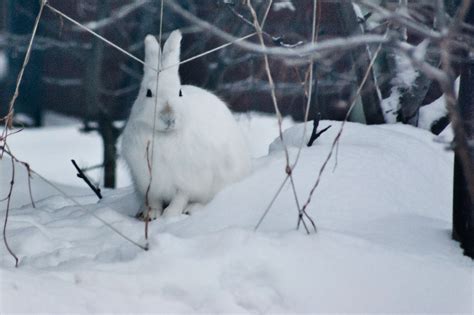Vinterhare: A Snowshoe Hare with Many Adaptations

Vinterhare: A Snowshoe Hare with Many Adaptations
Vinterhare, also known as the snowshoe hare, is a small mammal that inhabits the boreal forests of North America. It is known for its large feet, which act like snowshoes and allow it to travel easily through the snow. The snowshoe hare also has a thick, white coat during the winter months, which helps it camouflage itself from predators.
Physical Characteristics
The snowshoe hare is a medium-sized hare with a body length of 18-22 inches and a weight of 2-4 pounds. It has long, slender legs with large feet that are covered in fur. The fur on its feet helps to distribute its weight and prevents it from sinking into the snow. The snowshoe hare also has a short, rounded tail. Its ears are long and pointed, and they are tipped with black.
Habitat and Distribution
The snowshoe hare is found in the boreal forests of North America, from Alaska to Nova Scotia. It prefers to live in areas with dense vegetation, such as forests, swamps, and meadows. The snowshoe hare can also be found in open areas, such as fields and clearings.
Diet
The snowshoe hare is a herbivore and its diet consists mainly of twigs, leaves, and bark. It will also eat fruits, vegetables, and insects. The snowshoe hare is a browser and it feeds on a variety of plants. It will often clip twigs from trees and shrubs and eat the leaves and bark. The snowshoe hare will also eat fruits and vegetables, such as apples, carrots, and lettuce.
Behavior
The snowshoe hare is a solitary animal and it spends most of its time alone. It is most active at dawn and dusk, and it spends the day resting in a sheltered area. The snowshoe hare is a territorial animal and it will defend its territory from other hares. The snowshoe hare is a good swimmer and it will often take to the water to escape predators.
Reproduction
The snowshoe hare breeds twice a year, in the spring and fall. The gestation period is about 35 days and the female will give birth to a litter of 3-5 young. The young are born in a nest that is lined with fur. The female will nurse the young for about 4 weeks and then they will become independent.
Lifespan
The snowshoe hare has a lifespan of about 7 years in the wild. However, it is not uncommon for hares to live for 10 years or more in captivity.
Threats
The snowshoe hare is preyed upon by a variety of predators, including wolves, coyotes, foxes, and owls. The snowshoe hare is also hunted by humans for its fur and meat. The snowshoe hare is a popular game animal and it is hunted in many states and provinces.
Conservation
The snowshoe hare is a common species and it is not considered to be threatened or endangered. However, the snowshoe hare is susceptible to population declines due to habitat loss, hunting, and climate change.
Interesting Facts
* The snowshoe hare is the largest hare in North America.
* The snowshoe hare can run up to 30 miles per hour.
* The snowshoe hare can jump up to 10 feet in the air.
* The snowshoe hare is a good swimmer and it can often escape predators by taking to the water.
* The snowshoe hare is a popular game animal and it is hunted in many states and provinces.
Conclusion
The snowshoe hare is a fascinating animal that is well-adapted to its environment. It is a beautiful creature that is a joy to watch.
